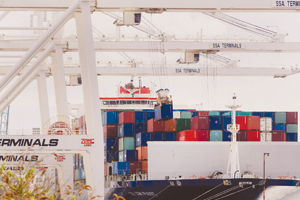West Coast Dockworkers to Vote on Pact as Ports Continue to Cut Freight Backlog

This story appears in the April 13 print edition of Transport Topics.
West Coast dockworkers will vote on a tentative port contract over the next month as truckers and terminal operators continue to clear the cargo backlog caused by labor slowdowns during the recent negotiations.
The tally of votes cast by 20,000 workers at 29 ports will be released May 22, the International Longshore and Warehouse Union announced. Leaders of a 90-member union caucus had to vote to approve the five-year deal reached with the Pacific Maritime Association before rank-and-file members could vote. Terms of the contract have not been released.
Meanwhile, carriers, ports, shippers and others outlined the extent of progress being made and the consequences of congestion.
“It seems like things are better than they were earlier in the year,” Fred Johring, chairman of the Harbor Trucking Association, told Transport Topics on April 8.
On the positive side, he said a newly created chassis pool has eased the lack of that equipment overall, though some shortages still exist.
On the other hand, Johring said, “the productivity of trucks is far below an acceptable level” because drivers spend too much time inside terminals.
He said 60% of Southern California port truckers’ time in terminals exceeds one hour, which should be maximum time.
“The big ships are having a major impact on these terminals,” he said.
“The ports continue to clear the backlog caused by the slowdowns and congestion during the contract negotiations,” said Jonathan Gold, a vice president for the National Retail Federation group that represents shippers. “While they are making progress on the vessels, congestion remains at the gates. The ports must work now on defining the ‘new normal’ and address the continuing issues impacting congestion and the efficient movement of cargo in and out of the gates.”
As shipping alliances put multiple ocean carriers’ freight on a ship that can handle 13,000 or more industry-standard units, Johring said, truckers and terminals are trying to cope with increasing complexity.
A single terminal that used to have just six container stacks now has 33 to accommodate the multiple carriers’ boxes. Each container stack now is five high instead of three, he said, which can double the time it takes for a trucker to obtain the right box.
Several recent indicators outlined the progress and the consequences from the disruptions.
Reports from BNSF Railway and Union Pacific Railroad showed the railroads are catching up after intermodal freight levels lagged last year’s first quarter by about 10% through February. As the first quarter ended, their combined truck/rail freight total fell 4.2%.
The Marine Exchange of Southern California said the number of containerships waiting to unload was eight as of April 7, down sharply from the peak of 28.
In recent days, several East Coast ports reported sharp increases in cargo sent there to avoid West Coast delays.
The largest percentage increase was 18% at Charleston, South Carolina, where 152,925 industry standard 20-foot units, or TEUs, were handled in February, the latest totals available for any port.
Savannah, Georgia, the nation’s fourth-largest container port posted a 14% increase to 284,037 TEUs and third-largest New York-New Jersey rose 11% to top 908,000 TEUs. Houston reported 40% higher loaded containers in February.
West Coast ports’ cargo declines approached 30% in February during the final stages of talks leading to the Feb. 20 tentative deal.
Another sign was a survey of 400 ocean carrier customers by trade magazine American Shipper, which was done at the height of the cargo disruption and released last week.
That survey found that shippers were prepared to shift as much as 20% of freight from the West Coast docks, which today handle about half of U.S. international container cargo.
Another indicator, reported by Bloomberg News, was a rise of 22% in February of airfreight activity on Asia-Pacific routes that touch the United States.
Johring, who is president of Golden State Express, also said changes to the chassis pool May 1 hold the promise of further improvement.“This agreement required 10 months of negotiations — the longest in recent history,” ILWU International President Bob McEllrath said in a statement. “Longshore men and women on the docks will now have the final and most important say in the process.”

